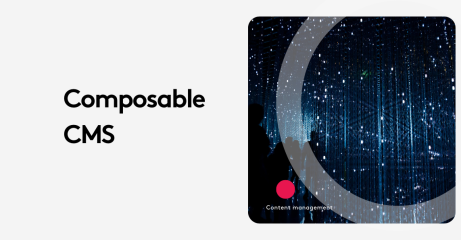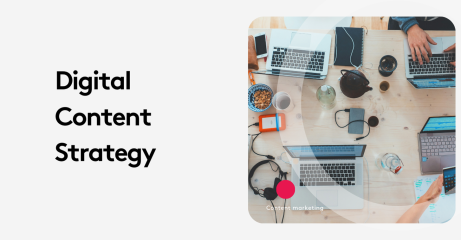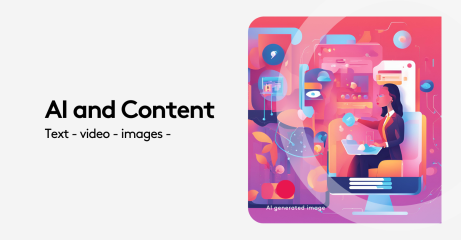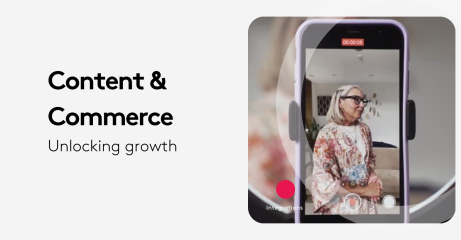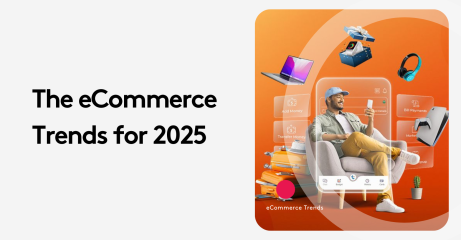11 Secrets on How to Grow Your Agency

It’s undeniable - running, growing and profiting from a marketing agency is bloody hard!
If finding and winning the right clients, delivering results, whilst also attracting, training and inspiring the right people aren’t hard enough, then throw in a constantly evolving marketing field where budgets ebb and flow every quarter and you have the making of a phenomenally tough business.
Yet, when done right, running an agency is exceptionally rewarding - creatively and financially.
So, how do successful agencies deal with these problems?
What ingredients do they all have in common?
What steps can you take to build a more successful agency?
We collaborated with Sujan Patel of Web Profits, Ed Leake of Midas Media, Johnathan Dane of KlientBoost, Allen Burt of Blue Stout, Martin Sawinski of 3five and Jonathan Anderstrom, Creed Interactive.
Let’s find out what we learned from them!
On this page:
1. Focus on a specialization
There seems to be a disconnect between what agencies offer and what’s actually successful.
Case in point: over 32% of respondents in a Moz survey identified themselves as “full-service” agencies or “digital marketing” agencies.
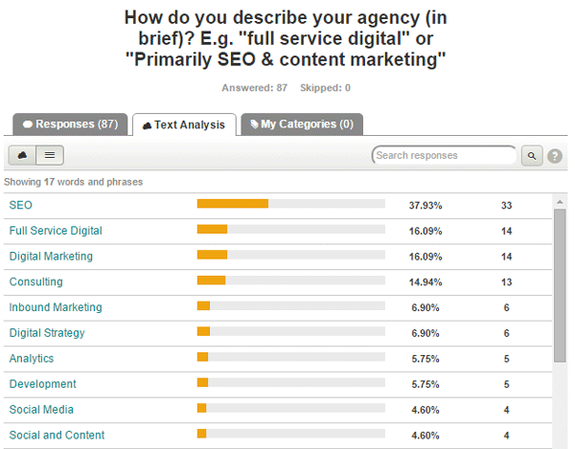
(How do you describe your agency | Moz Survey)
Yet, our interviews showed that successful agencies almost always focused on one field or vertical. Consider this list:
- KlientBoost focuses on PPC.
- Web Profits focuses on content marketing.
- MidasMedia focuses on PPC.
- Blue Stout Media focuses on eCommerce clients.
As Blue Stout’s Allen Burt says, the “secret sauce” of success is their:
“...Laser focus on helping eCommerce companies design, build and optimize their website to exponentially grow their sales and profits. We focus on one type of client; eCommerce businesses, and make sure they see results.” [Click to tweet]
In one survey, SoDA Report found that more clients depend on specialized agencies than full-service agencies for their digital assignments.
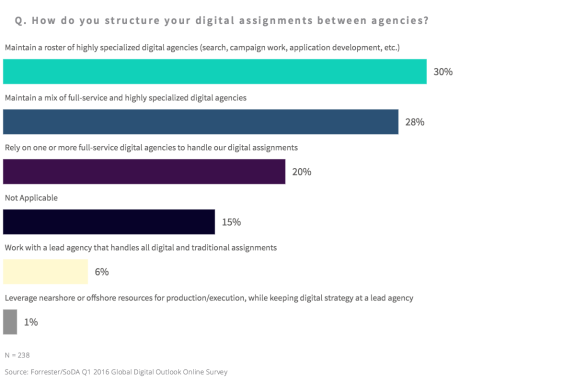
(2016 Global Outlook Online Survey | Forrester/SoDA Q1)
Besides helping you stand out in the crowded marketing space, specialization also helps you:
- Create better content: With content marketing emerging as a cornerstone of agency success (see below), specialization ensures that your content is more relevant and focused.
- Develop better project management processes: When you focus on one skill or client type, you can better develop processes and templates to deal with similar challenges.
- Earn better rankings: It’s harder to rank for “digital marketing agency” than it is to rank for “real estate marketing agency”.
2. Build your agency around a “Personality”
When you’re competing against thousands of similar agencies offering similar services, standing out can be the hardest job.
One way to solve this problem is to develop your brand around a “personality” - usually around one of the founders
When you’re writing guest posts, hosting webinars, or appearing on podcasts, this person will be the “face” of your agency.
Most agencies tend to hide behind stock images and generic copy, like this:
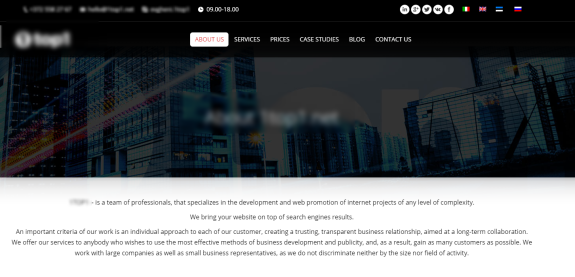
(Example agency 'About Us' page)
Even if they do mention the team behind their business, their brand never really focuses on an individual.
Contrast this with KlientBoost.
KlientBoost’s branding revolves around its CEO and founder - Johnathan Dane. You’ll see his face at the top of the company’s “About” page...
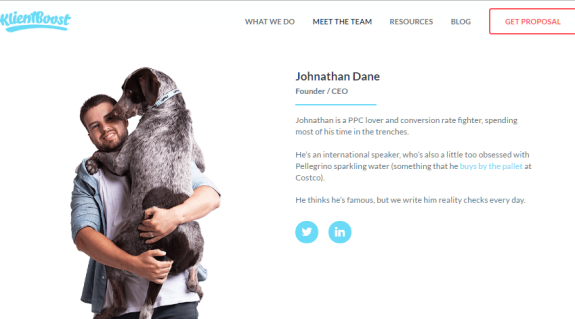
(Meet the team | KlientBoost)
In live chat boxes:
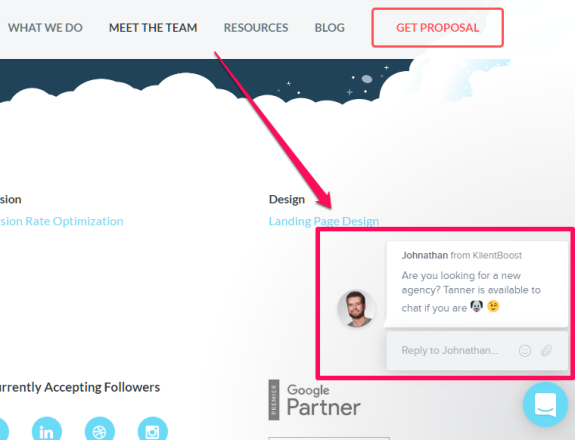
(Chatbot | KlientBoost)
As well as on all KlientBoost podcasts, interviews and guest posts:

(Podcasts, interviews and guest posts about KlientBoost)
It’s important to not fake your size. In fact, the best agencies embrace the fact that they are small and play it as a strength (they can give clients personalized attention).
Even when KlientBoost was a small company, they made no bones about their size:
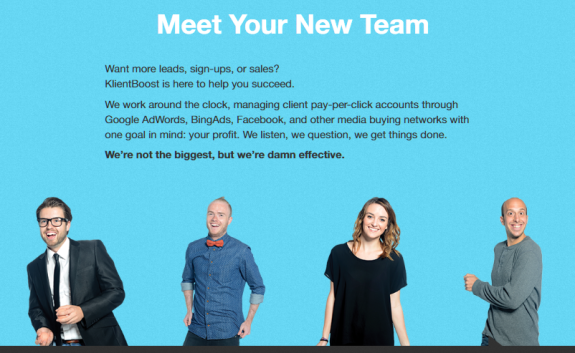
(Meet Your New Team | KlientBoost)
You’ll find that this is common to a number of agencies. Rand Fishkin was unmissable on Moz back when it was still an agency. Single Grain and Eric Siu’s blog, GrowthEverywhere, are heavily interlinked. Ed Leake is omnipresent as far as Midas Media is concerned.
In a way, this is continuing a long-standing agency tradition: to brand the agency around a single person. This was true for Ogilvy & Mather (which even had David Ogilvy’s signature as the company’s logo), Saatchi & Saatchi, and Cohn & Wolfe.
But how do you go from “founder” to “brand-personality”?
Here are two tips:
A. Use the same profile image everywhere
Repetition is a crucial aspect of branding. Make sure that you use the same profile picture everywhere. For instance, here is Rand Fishkin’s profile on the Moz blog:

(Rand Fishkin's profile | Twitter)
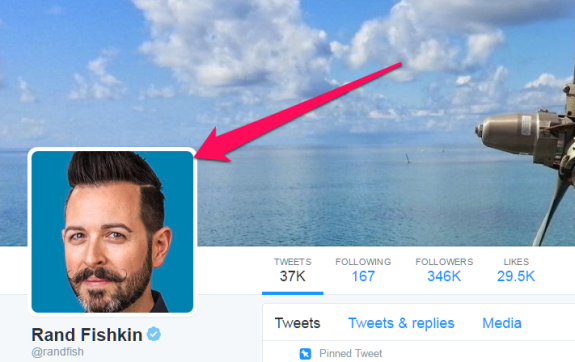
(Rand Fishkin's profile | Moz blog)
And here is Rand’s Twitter profile:
B. Get published on third-party websites
While publishing content on your own blog or sending out tweets is great, if you want your business to be associated with you, you have to be seen on third-party websites. Think guest posts, podcasts, interviews, round-ups, etc.
For example, besides the Midas Media blog, you can find Ed Leake writing guest posts:
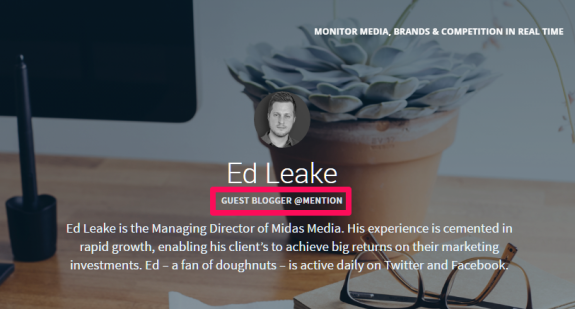
(Ed Leake's profile | Midas Media)
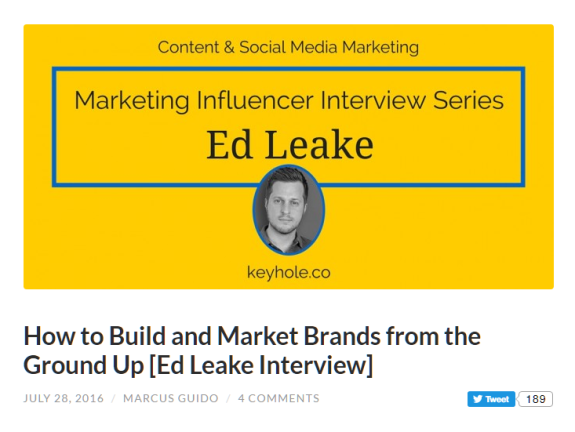
(Ed Leake Interview | Marketing Influencer Interview Series)
And even hosting AMAs:
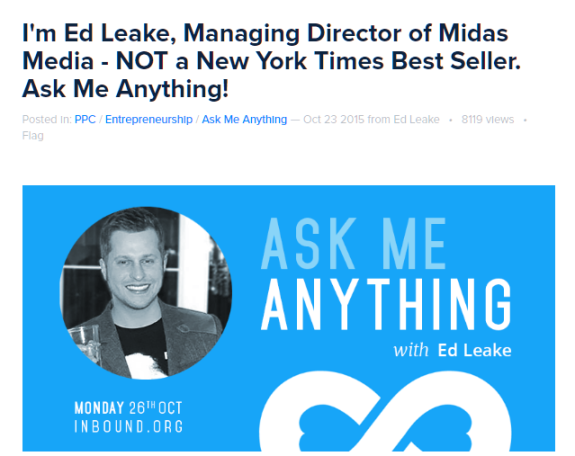
(Ed Leake hosting the AMAs)
3. Focus on building a brand
While developing a founder-personality for your agency is important, it can’t replace good old-fashioned branding. As Johnathan Dane reminds us:
“If you look at our competitors, there's literally no barrier to entry of starting a marketing agency. Anyone can say they do it. But what they can't do, is build brand equity.”
KlientBoost has this brand equity in spades with what Johnathan calls “a funny combo of design and immaturity.
You’ll find an example of this combo in KlientBoost’s ‘about us’ page, which includes an appearance from Tanner, the office mascot:
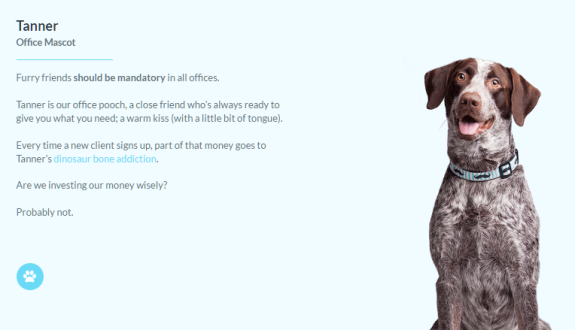
(Tanner the Office Mascot | KlientBoost)
This sense of design + immaturity can be seen in its content as well, which includes a conference talk that used poop-emojis.

(The PPC Poop Emoji Scale | Autopilothq.com)
Head over to Creed Interactive and you’ll see the same thing: distinct design that’s nothing like cookie-cutter, made-from-a-template agency websites.

(Creed Interactive's website)
In the crowded agency space, branding is inherently tied to memorability. When you develop a brand persona that stands out, you eliminate a lot of competition from low-priced, anonymous providers.
As Sujan Patel of Web Profits says:
“You have to build a brand and kinda market for yourself too. It's not forgotten, it's just not emphasized enough”
Marketers themselves rank branding as one of their top priorities. In one HubSpot survey, “branding” was ranked as the number one concern among senior digital marketing leaders, above customer acquisition and data analysis.
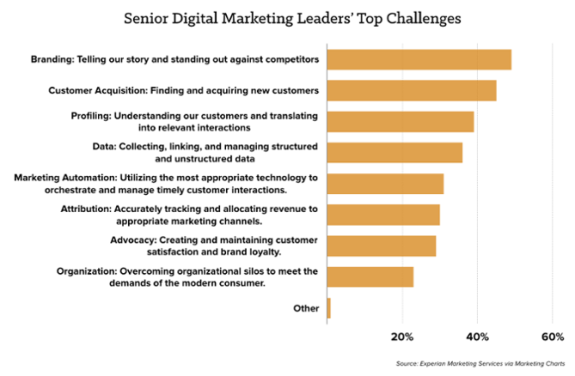
(Senior Digital Marketing Leader's Top Challenges | Marketing Charts)
Johnathan Dane has something to say for fellow agency owners:
“The truth is, most marketing agencies suck at marketing themselves. It's easy to improve performance for clients when things are already set up, but if the UX and branding are crap on where you hope to convert visitors, you'll have a hard time.” [Click to tweet]
In other words: focus as much on branding as you do on selling.
4. Become your own client
How do you demonstrate your expertise, learn new skills and get new clients?
Easy: by becoming your own client.
When you “hire” yourself, you do three things:
- You actively promote your business
- You demonstrate your expertise and pick up new skills
- You get a better understanding of your target audience
Web Profits, for example, focuses on content marketing. Fittingly, it uses content marketing to market itself.
This includes a regularly updated blog:
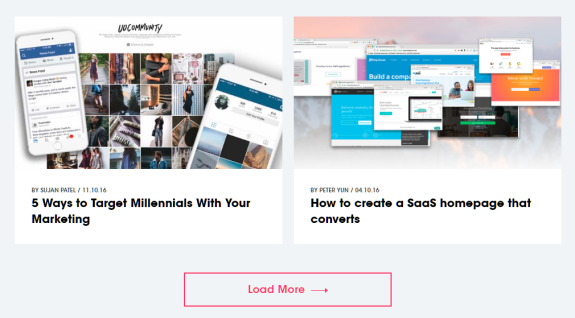
(Example of a regularly updated blog)
As well as regular guest posts from its founder and founder-personality, Sujan Patel:
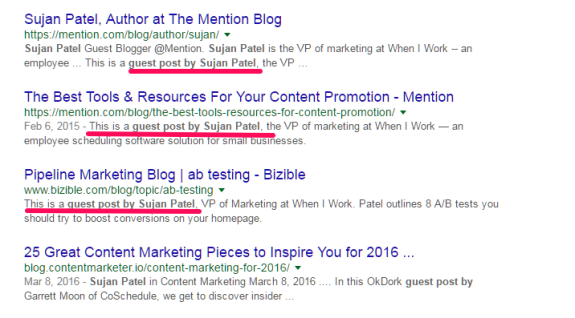
(Sujan Patel guest posts)
Here’s what Sujan had to say about hiring yourself:
“You have to focus not just on providing services. We treat ourselves like a client and say, ‘Okay, what are we going to do to grow our business? What are we going to do to grow the leads? What are we going to do for this and that?” [Click to tweet]
Hiring yourself as a client also gives you an opportunity to build something. This goes beyond capturing new leads; you get to test out real-world skills and even start tangential businesses.
For example, ThoughtBot, a design and development agency, have created many tools like:
- Bourbon, a lightweight tool for the CSS preprocessor Sass
- Neat, a semantic grid framework
- Hound, a service for commenting on Ruby on Rails style violations.
These all started out as an experiment but turned into a standalone product and a lead generating machine. Check out more of ThoughBot’s tools at Github
In the long-term, you can turn this “building something” process into a full-fledged “innovation lab” for coming up with new products and solutions.
In a HubSpot survey, a majority of agencies reported getting new clients because of products and learnings from such innovation labs.

(The New Business Benefits of an Innovation Lab | SoDA Agency Ecosystem 2015)
5. Find strategic partners to increase your growth
The marketing world is hard and you can’t succeed on your own. One common element among successful agencies is their ability to find strategic partners to share opportunities with.
Sujan Patel’s Web Profits is the perfect example of this. Web Profits was already an established agency with a strong brand name in Australia but had no established US presence. Instead of building an agency from scratch, Sujan partnered with Web Profits to bring them to the US.
He says:
“So instead of starting a business from scratch, and building - hiring a team...I partnered with Web Profits to form a US entity, where we take their name, and we use existing staff to grow.”
This strategic partner doesn’t have to be a port of an established business into a new territory. It can be something as simple as becoming a Google Partner (like KlientBoost).
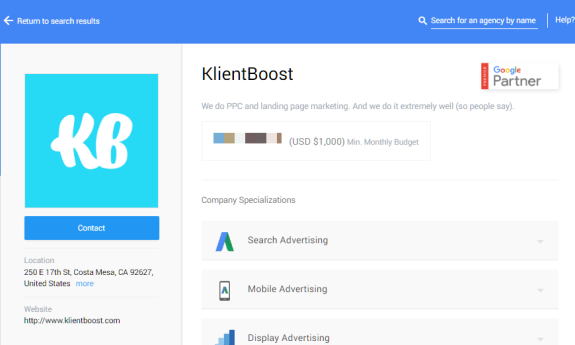
(KlientBoost)
Try looking up opportunities in your specialization for partnering with larger players. Businesses that offer an ancillary service or product make for great partners.
Here’s a step-by-step process for finding and developing such partnerships:
- Identify your current weaknesses and requirements (“lack of leads”, “zero PR”, “poor search engine rankings”).
- Find larger or similar-sized players in related niches who can deliver what you want.
- Identify weaknesses in your target partner’s marketing especially in areas of your specialization.
- Barter or collaborate in a way that benefits you and your partner.
For example, eCommerce agency with a lead problem can try partner with a payment gateway or a CRM services provider to introduce, share and collaboratively pitch to prospective clients.
6. Hire based on fit, not (just) resume
Marketing agencies consistently rank hiring as their biggest challenge.
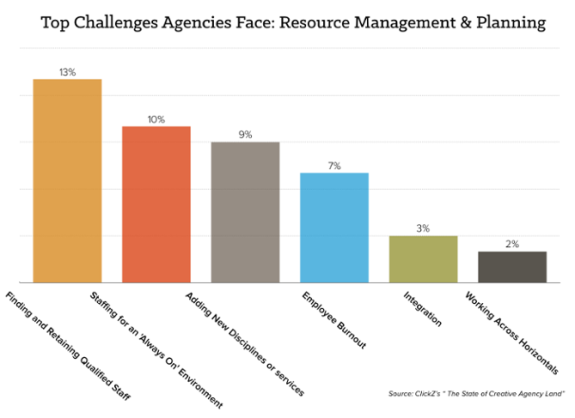
(Top Challenges Agencies Face: Resource Management & Planning | ClickZ)
This was reflected in our interviews as well. Ed Leake of Midas Media said:
“The single biggest challenge of all is not the work or the plan, getting worn down, worked too hard, stretched thin or trying to reinvent the wheel twice daily – no, it’s none of those, it’s hiring.”
Conventional hiring practices - studying resumes, shortlisting candidates based on past experience, etc. - don’t really work for the fast-paced digital marketing world. In an environment where new developments can undo years of experience, resumes make for poor storytellers.
Even more, resumes can’t tell you about how a new hire might fit into your agency. And for new agencies, an employee who doesn’t fit can be disastrous.
To combat this problem, go beyond skills or resume and look for:
- Cultural fit: In interviews, ask yourself: would I grab a beer or have dinner with this person? If the answer is anywhere close to “no”, look elsewhere.
- Scrappiness: In a young agency, your employees will have to wear multiple hats and make do with limited resources. Scrappiness - the willingness to find ways to get things done - is a critical employee trait.
7. Hire (and fire) at the right time
It’s not just about hiring the right people; you also have to hire them at the right time.
Agencies are often simultaneously guilty of over-hiring and under-hiring. They might hire a designer when they don’t have a lot of design work while their development work lags because of over-dependence on freelancers.
According to Jonathan Anderstrom of Creed Interactive:
“One of the hardest problems running a company that has grown 10% - 50% every year for the past 10 years is knowing what positions to create, the seniority of those positions, and when to make those hires. What do you do when you need a marketing person at 25% or 1.33 new developers or a project manager at 66% today but need that same position to be at 120% at the end of the year.”
But while hiring at the right time is important, the obverse - firing - is critical. A bad hire not only costs you resources but can affect the agency culture as well. When you look at the reasons for startup failure, team issues rank at the very top:
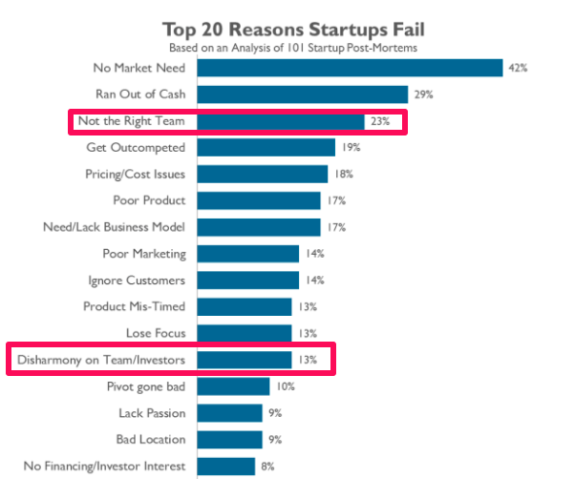
(Top 20 Reasons Startups Fail | Fortune)
This is why it is crucial to get the balance between hiring and firing just right.
Ed Leake of Midas Media:
“Hiring the right people at the right time and firing the wrong ones are paramount to success. Getting the balance right is by far the most difficult area of running a business, especially when there’s only a single person in charge of hiring, firing and ‘HR’ duties.” [Click to tweet]
For first-time founders, firing can be particularly hard. But Sujan Patel advises that you should take emotions out of firing and treat it like a business decision.
“Firing is more of an emotional thing. It's like, "Oh I can't. I don't want to do this. I can't do this." I think at the end of the day, you just need to pull the trigger. And it's not an emotional thing, business is not an emotion.” [Click to tweet]
8. Build relationships with clients and focus on referrals
If there is one thing all successful agency founders unanimously agree, it’s the importance of building client relationships.
Here’s Jonathan Anderstrom of Creed Interactive:
“Any service business like ours - designing user experiences and writing back-end code - is based on relationships. Having had close to 10 years to develop relationships has been a ton of work but very rewarding and has helped us continue to grow.”
In fact, Sujan Patel of Web Profits even advocates working with an important client even when it doesn’t make immediate economic sense just to build relationships:
“We took a lot of leads that maybe weren't going to pay us money now or like - it wasn't worthwhile from a monetary value. But we knew that relationship could help.”
Sujan later mentions how building relationships with marquee clients like Yahoo helped him get tens of thousands of additional business.
“I did whatever it took, probably broke even, if not lost money on the deal with Yahoo to get the Yahoo name and to get the relationship. And that relationship [with] Yahoo have given me probably two to three hundred thousand dollars in business since then.”
This is the real reason why relationships matter: referrals.
Despite the growth of content marketing or social, an overwhelming number of agencies rank referrals as their best source of new leads, as per one HubSpot survey.

(What sources best generate new leads to your agency | RSW/US Repor
These findings were corroborated by another RW/US survey which found that referrals and networking ranked as the best source of new clients.

(Most Valuable Source of New Business for Agencies | RSW/US Report)
Your clients are more likely to refer you to their industry friends when you have a standing relationship with them.
Martin Sawinski of 3Five:
“The relationships we build with our clients, and their trust in us, has been rewarded by endless referrals and praise”. [Click to tweet]
In the words of Allen Burt of Blue Stout:
“At the end of the day, focus on the client. Everything else is noise.” [Click to tweet]
9. Adopt a culture of transparency
Traditionally, agencies have been defined by opaqueness. Clients often don’t know why they are being billed at their existing rates, and employees have no idea what the agency is actually pulling in.
For modern digital agencies, this approach simply doesn’t fly.
Your employees live in a world where Buffer shares its revenue dashboard and Ramit Sethi shares actual revenue figures and conversion rates for his new launches.
Hiding key facts from your employees - your long-term vision, short-term goals, and even the cash left in the bank - can backfire.
As Ed Leake says:
“Communicate your vision, clearly and regularly to the staff. Be open and transparent with targets and growth, and even the bank balance.” [Click to tweet]
10. Don’t make yourself indispensable
Agency life - at least in the early years - is defined by juggling far too many responsibilities. As a founder, you’ll be responsible for hiring people and managing clients while also keeping abreast of industry changes.
Johnathan Dane of KlientBoost says:
“Right now, my biggest challenge is still that I wear too many hats. I know I'm good at a lot of things, but once I specialize in our own marketing and sales, that's when my time is best used”
This problem becomes even more acute when you’re the sole founder. And the number of such agencies is on the rise - on a Moz agency survey, more than 70% of respondents identified themselves as sole founders.
Without anyone to share initial responsibilities, you become your agency’s CEO, CMO, CFO, COO, and head of HR.
As Martin Sawinski of 3Five says:
“As a solopreneur, I’m responsible and tasked with all aspects of the C-suite”.
This makes it all the more important to set up processes for handling different aspects of the business - something our interviewees identified as a top priority.
Ed Leake of Midas Media:
“I’ve never worked harder than I am now to make myself redundant. In the sense that the business must operate without me and I become an advisor, not an operator.”
In other words, you, the founder, should not be indispensable to the company. Figure out what you’re good at (and what you enjoy) and focus on that. The rest, delegate.
11. Be selective with your clients
If there was one thing every founder we interviewed agreed on, it was the importance of doing work you can actually deliver.
Ed Leake of Midas Media:
“We’re very selective about who we work with. We’re a PPC specialist because that’s where we really, really deliver.”
Martin Sawinski, when asked what makes 3Five successful, had this to say:
“If I have to pick one thing, it is our candid no bullshit approach taken with each project. We aren't afraid to pass up money if the idea isn't a good one or able to prove to be a positive result for the client.” [Click to tweet]
Consider the reasons why clients fire agencies:

(SoDA Report 2025)
Most of these reasons have to do with the agency’s experience, execution or expertise.
These problems arise when you take on clients you are not sufficiently equipped to handle. While it can be hard rejecting clients when you’re starting out, being selective will give you a healthier roster of clients.
Over to you
Building a successful agency is hard work, but as these six agencies show, it can be done. The details might differ but the fundamentals remain largely the same, regardless of your vertical.
Focus on developing relationships, build processes to handle key issues, hire the right people at the right time, be selective with your clients and you’ll be on your way to agency success.


